Belief in Building, Chapter 2: Back to the beginning
Chapter 2: Back to the beginning
Author: Alistair Knox
With more time to plan, I returned to the ways of the earlier days. I had been through the technical period. This was necessary. But it was good to get back to positive statement, unfettered by any restraint except that of structure.
One of the first things was to find some land on which to build for ourselves. Margot and I drove solemnly around Eltham one Saturday afternoon. We both agreed that if we had the choice, one certain piece of rural land - hill and swamp and bush, mass and void - would be it. I did not know who owned it, but I did know the nearby orchardist. Two weeks later I went to see him. His sister made herself known to me on the back verandah of the typical Eltham rural cottage.
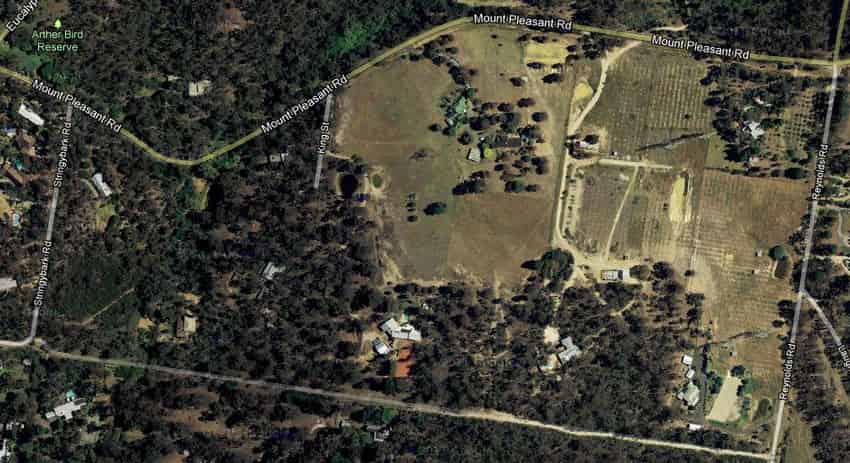 Eddie Anderson's orchard. The heavily treed section between King St and Stringybark Rd is the section that Alistair bought. Google Earth
Eddie Anderson's orchard. The heavily treed section between King St and Stringybark Rd is the section that Alistair bought. Google Earth'Are you looking for Eddie?' she asked. 'He's digging in the quince orchard'.
I had intended to ask him who owned the land, but what I actually said as I shook his rough and knuckly hand was, 'I don't want to muck you about, Eddie. Can you sell me some land?'
He had curly, grizzled, grey hair and a lovely smile. 'Yes, Alistair. I can', he said. I was surprised. It was the last thing I had expected.
'Where is it?'
He took us - I had Margot with me - through the fence and put our feet on the very land we had pointed to as our selection.
'Eddie,' I said when he told me its dimensions. 'There are two things'. I went on to tell him that I had no money at present and that I would have to subdivide as the land was too large for my purposes. I finished by saying, 'And I can't help making money out of that subdivision'.
Eddie's reply was completely typical of him. 'Alistair, you can pay me when you like. I hope you make a lot of money out of the subdivision - and I want you here ...' He asked me further not to tell anyone what I was to pay for the land, as he himself thought it was 'a gift'. Later he told me he thought it was a miracle that I came to see him. He and his family had owned the property since 1848, a few years after the founding of Melbourne; and he had arranged for a surveyor to come in the following Monday to subdivide this piece from the parent title.
I learned one important thing in that transaction. It was that they who wait upon the Lord shall renew their strength. They shall mount up with wings as eagles. They shall run and not be weary and shall walk and not faint. The ambitions I had set my heart on nearly twenty years earlier had not prospered because I had not set Christ first in my life. When I thought I should lose all by doing so, I found it to be a new and miraculous beginning.
It was necessary to start building immediately, so that I could vacate our then present properties. I felt they should be sold for an exact amount, without agents and without fuss. This is exactly what happened. Only one thing dragged - the settlement of the largest of the properties. Even this was an essential part of the plan. It enabled us to move into the first of two wings of the new house on the very day that the purchaser returned from Europe. Never did a building operation bring such joy and satisfaction. The limited time prevented many factors that could have been used. I did as I had done in the immediate postwar period: contrived how and where I could.
High-school boys asked for work in December, at the end of the school year. I had them make mud bricks. I took Lionel, the foreman, who organised and encouraged them. We had no reticulated water supply, so we hired a pump and drew it up from the valley. Bit by bit, under Lionel, those boys put a roof on the first two wings. Christmas came, and immediately afterwards I commandeered a group of our carpenters for a couple of weeks. We were compelled to leave the old house, and we made it to the very day. Water, power, and sewerage were ready within twenty-four hours of our taking possession.
It was a bit like an anniversary of the early days of mud-brick building. The colourful figures were replaced by high-school boys and one or two architecture students. But Keith Joslyn came from time to time to break more earth for the bricks, and to shape the land. It was great to be back. The spirit we start with is the spirit we never lose. The bush land site was identical with the character of our Eltham building tips of 1948 to 1950. Nostalgic figures began to call in to see how it was all going. It was not that earth-building is the only exciting medium, but it is so homogeneous and environmental. It is a key to imaginative construction.
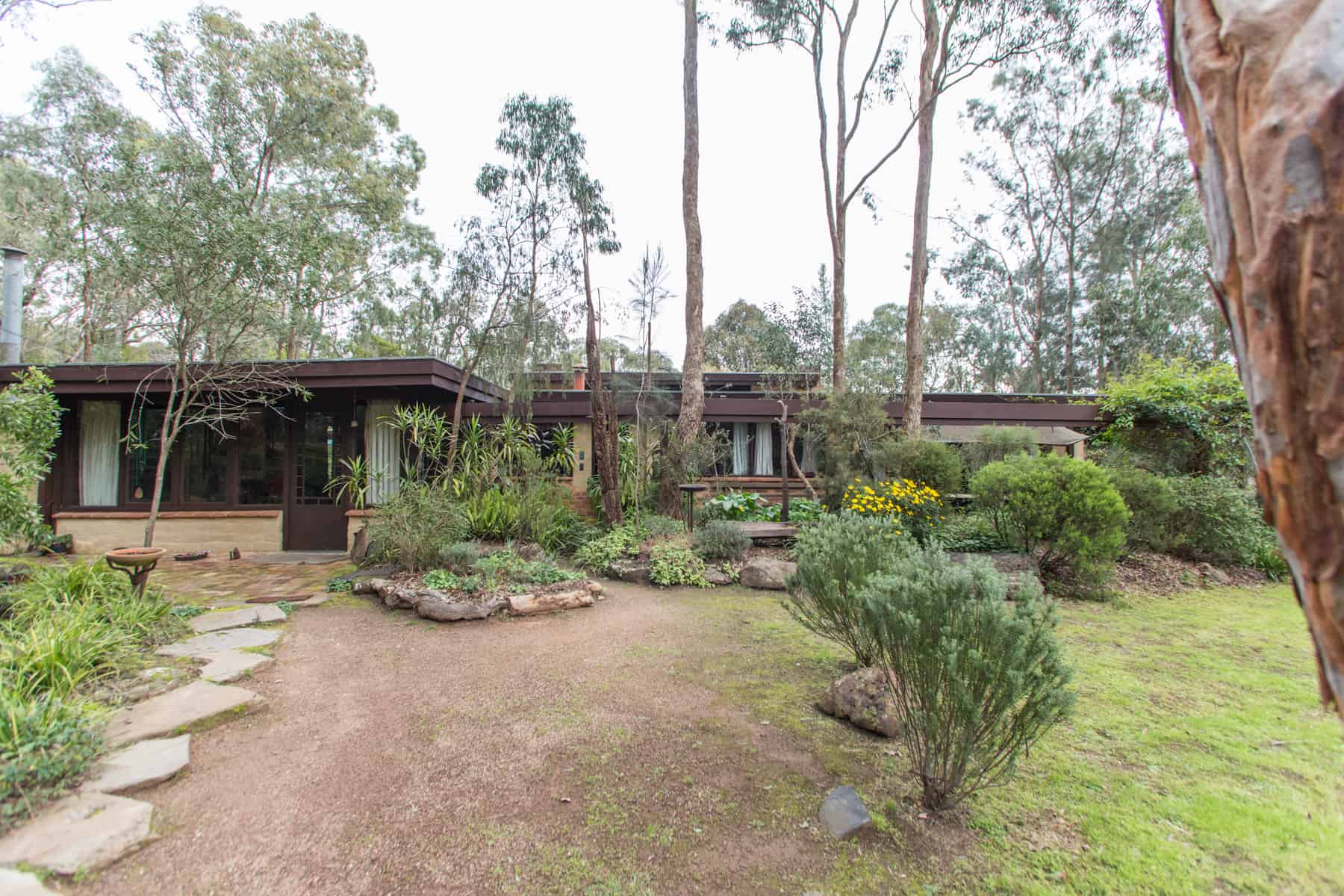 The Knox house , Eltham Photo: Tony Knox
The Knox house , Eltham Photo: Tony Knox
The new house was large, but on the appointed day we only had the east and north wings complete. The plans were simplicity itself: four wings surrounding a courtyard room, lit from all sides by clerestory windows. I was determined not to borrow money on the project - I had had enough of that activity - so that when we moved in, the money had momentarily been spent. Planning fees kept coming along, so that the work could be resumed. There were stacks of mud bricks to be laid, so I took on the job myself which, except for Tarnagulla fifteen years earlier, was the only time I ever did so.
The tensions of the previous three years had left me physically exhausted, and I developed asthma. The building of these walls made me so stiff and exhausted that I realised I could not continue. The following weekend I found myself gazing out the window and wondering what to do. The mud-brick material was, oddly enough, only of average quality. Also, the bricks were pretty sloppy. I felt that to leave them outside for the winter would spoil them completely; but I was literally unable to continue working with the bricks and do my ordinary work as well.
As I sat there, I saw a blue Volkswagen winding along the road, and then watched while it turned up into the property. A man stepped out. I knew him vaguely. 'I want to work for you', he said.
This was Eric Hurst, a natural tradesman in stone and brick-paving. In addition, he was a conscientious man with an eye to see and a heart to work.
Eric worked from the next day until the house was completed about twelve months later. He did it all himself. It remains a monument to his ability. It was the most pleasant building experience imaginable - even more gracious than the early Downing-LeGallienne house about a quarter of a mile away.
As if to confirm the matter, we had an open-house day for charity on the day the building was fully complete. Over one thousand people went through. It was one of those beautiful autumn days, and the house took the crowds in its stride. Best of all: when they went through, it was impossible to tell they had been there. Unquestionably, here was a timeless house in shape, size, texture, and character. It was also indestructible.
The concrete-slab construction which had been an automatic part of my design since 1948 was, in this instance, deleted. We poured footings only, and then laid a course of bricks all around, to a level. This formed a shallow tray inside. In this we laid slate, brick, quarry tiles, and jarrah timber floors, straight onto the earth. Whilst this was done initially to save a substantial sum of money, it also demonstrated belief in the country and in the capacity of true earth-moulding to keep the water out.
In the meantime, Dorian LeGallienne had died at the age of forty-six. His passing left a profound effect on all who knew him. To me, he represented both friendship and inspiration of the first quality. Dorian had capacity to see value in humble people and things. He was both visionary and practical. His great love for and understanding of the environment, and of Eltham in particular, left an indelible mark on all who knew him.
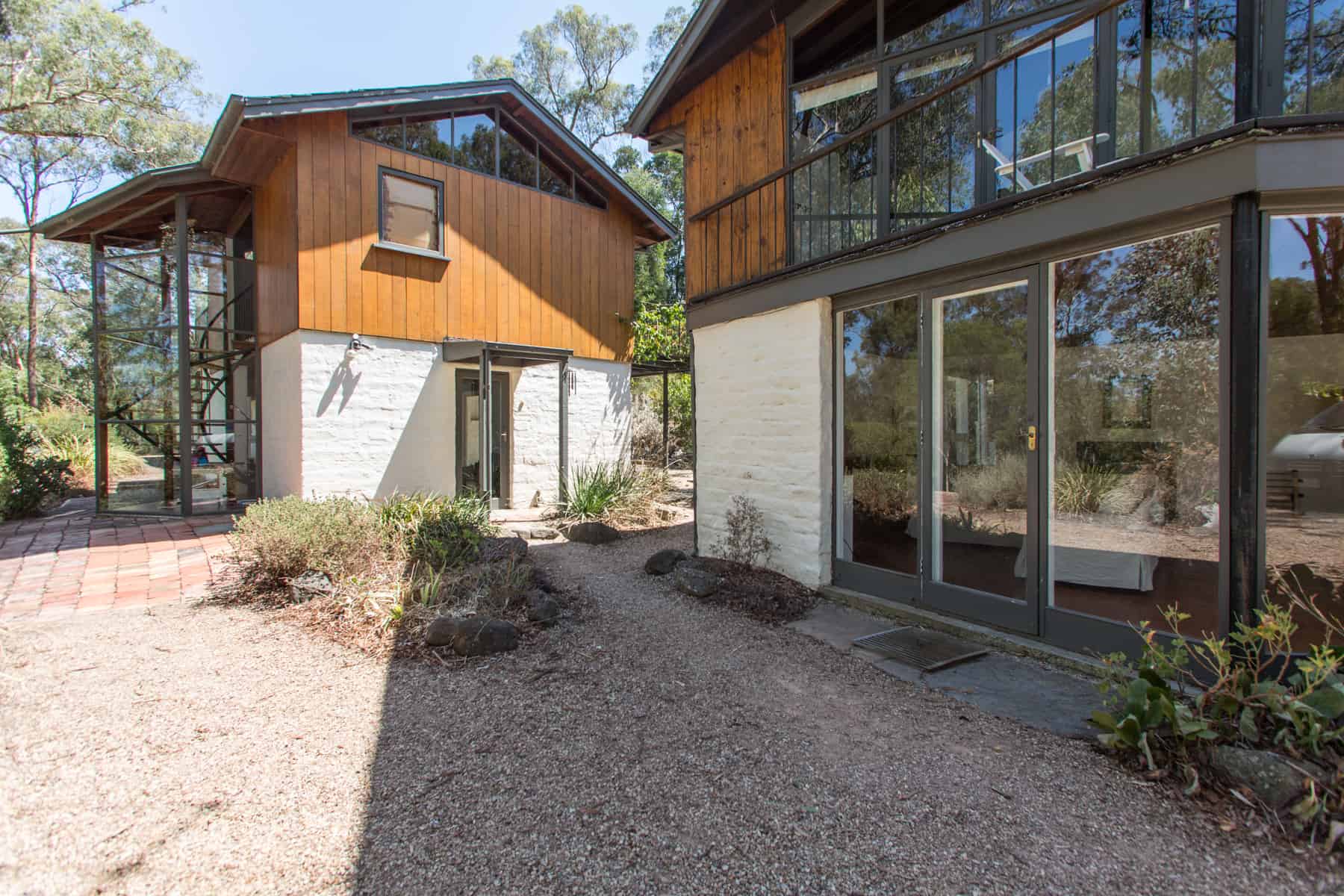 The Downing Le Gallienne house final stage. Photo: Tony Knox
The Downing Le Gallienne house final stage. Photo: Tony Knox
I did not see much of Dick Downing for about a year after that. Dick, who had been considered the most confirmed bachelor in Melbourne, phoned me one day.
'Al', he announced. 'I'm getting married - and I'm marrying a widow with six children'.
'I suppose you'll need some extensions, Dick'. He did. The fourth development of the LeGallienne-Downing house was put in hand at once. It was a large extension, but the initial rhythm of the house was reasonably maintained. We lost the pitched roof and timber ceiling of the original wing as we built over it. In some ways other things were lost, too. The balance between the externally connected buildings and intervening nature remained. But on the other hand, the structure took on the character of a pile. Gordon Ford came in later and resolved the garden. We could still feel the presence of Dorian and his ability to inspire us. The gang gangs still cranked as they flopped through the bush, and the pink and white evening sky of the Yarra Valley remained unchanged.
The satisfying aspect about this second start was that everything fell into place in a planned way. The very methods we used in the first Downing-LeGallienne house became part of my methods when I rebuilt for myself. All the original solid-timber walls of 1948 became strong and real again. The environmental experience took on new power, and the practice of the past was made perfect.
I introduced Eric Hurst to the adze and the morticing axe when he had worked on our new house. By degrees, large sections of wood found their way to the property, and Eric got to work chipping and chopping the hard jarrah, mountain ash, and ironbark and yellow box. One of the greatest of all the qualities of our sun-powered landscape is the tremendous weight and durability of the hardwood timbers as they survive the hot summers and the droughts to become dense and enduring. Real timber is destroyed once it is touched with a sanding machine. The finish must always be with steel. The integral quality of ancient furniture derives in many ways from this fact. The adze used intelligently creates a sense of sculpture, a sense of the primaeval in everything it touches.
We had to find second-hand timber that had become seasoned and inert through fifty years' use. Large sections of Australian hardwoods are tremendously heavy. We all rejoiced in the sense of winning back from the timeless a spirit of work equally timeless. It was a case of man equalling the measure of the work. The machine was secondary, and the result individual. For a long time I had wanted to get into these great logs which are so readily obtainable, and, in the second chance, the way opened up. We are just now getting into production.
Opportunities always open up when you are ready for them. One day a few months ago, a great gentle Dane named Edna, who had just migrated, came to work for me. He was a skilled joiner with a fine set of tools. He seemed a little taken aback by the size of an adze and the weight of the timber. But he set to work. His first efforts with the adze were of the Hansel and Gretel character, but this was soon settled. In no time, his tradition was welded into the timeless land. He can become an essential part of our new exploration of the opportunities of his new-found land. At present he has only one barrier. He wants to go to Lightning Ridge to become an opal digger. I trust the great heart of that fiery area will cause him to think again. As he wields the adze with these experiences behind him, he will create poems in timber - heavy in weight beyond imagining, and satisfying in shape, and timeless as the ancient land itself.
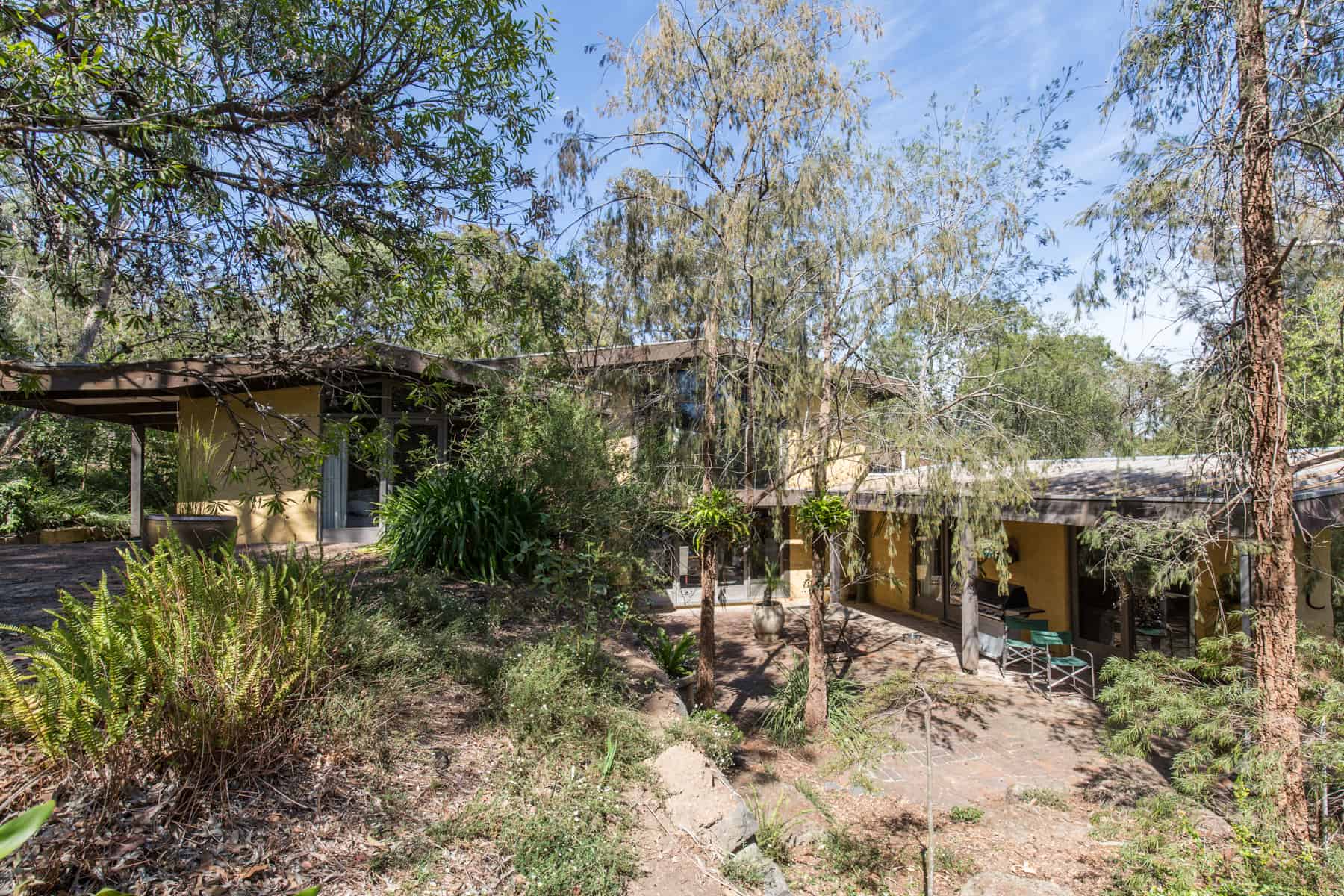 The Barden house Eltham, 1969. Photo: Tony Knox
The Barden house Eltham, 1969. Photo: Tony Knox
The building of our new house led to a variety of other buildings of good size and quality. More and more the opportunities came to exploit the unity between land and house. At the same time, it was important to discover universal methods of design that could become available to all. The Australian scene is entirely democratic. Men like Frank Lloyd Wright had the opportunity to work on a large scale because they worked for millionaires in a land of millionaires. Australia is a land where everyone is a thousandaire, but all have the liberty of the millionaire insofar as freedom of choice of work, leisure, and opportunity of expression are concerned. One of our great troubles has been recently that we are unconscious of just what privileges are ours. We have been wafted off into what one of the prime ministers has called a lotus land. To a degree, this is true. The trend will continue until we find a government and a nation who will take up the great opportunities of this technological age - and until we begin to take up the greatest pioneering challenge of all time: to make the red centre flower like the rose. At present, we are lotus-eaters governed by lotus-eaters. It is no use pointing to the rest of the occidental world, and saying it is not better. Should we not, rather, ask how we can be so bad when the opportunity lies at the very door?
Environment is greater than cities. Throughout the world the great cities have destroyed the environment in which they were founded, it is said, in almost every instance. The great loggers of the United States, of the last century retired because there were no more trees to fell. Australia has not the timber resources of that great land to destroy them by fire. We replace them with pine plantations. We cut them out without consideration, and then plant alien trees. Yet the Middle East, California, and other countries are planting eucalyptus by the millions. They have seen their particular qualities. We have not, because we are still close to the pioneers who saw them as enemies. From the air, it can be seen how diligent our clearing has been and how it has altered the natural surroundings. Where sections of land are still not cleared, you can see as you fly over the country in a light plane the denseness and growth as it once was. What is the balance? Where and how does the tide turn? Farm land rises to such a price that it must be fully exploited to make a small return on capital outlay. Farms can no longer be bought by ordinary people. They require to be inherited, or the investment of large companies. Quietly, but effectively, we are being separated from the land itself, like our English forbears during the Enclosure Acts.
Secondary industry alters the impact of the problem, but it does not solve it. The plain fact remains that, as we become separated from the environment, we become separated from life. Today's civilisation, for want of a better word, offers a multitude of substitutes. These range from sport to television, from striptease to art. But primarily, they destroy what they are required to maintain. They bring moral declension with them, for they themselves are indolent, separated from the true rut between existence and environment that has always been present in rising cultures and civilisations. In many lands, the challenge has gone forever. In Australia, our pioneers produced the climate of adventure. Today, we will allow it to die unless we renew our vows, re-direct our wills. If it were only for ourselves, it would not be valid. But the whole world cries out to us to go. And we, who have the exemplary tradition and the necessary vision, can no longer stay sulking at home.
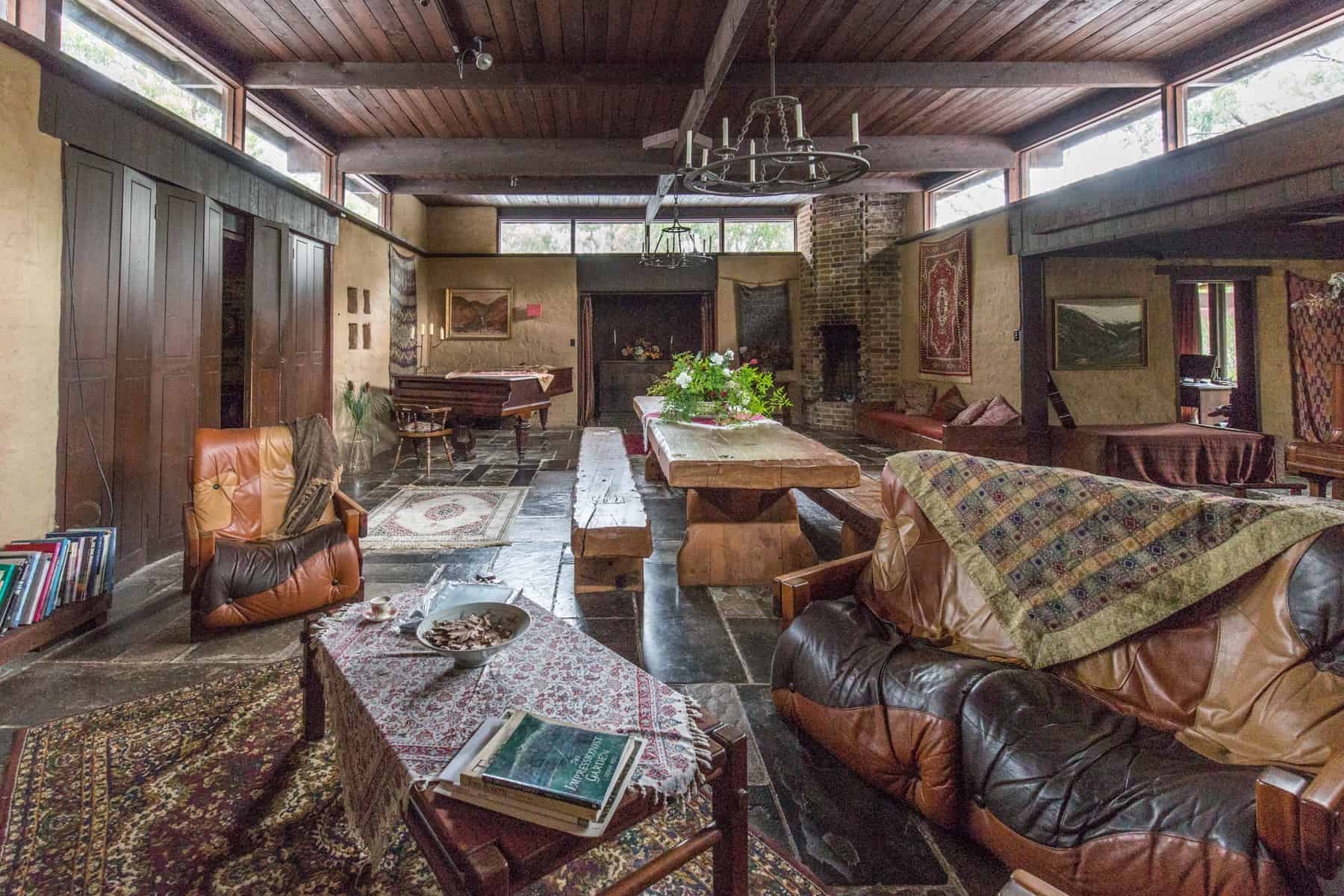 Interior main room Knox house, Eltham. Photo: Tony Knox
Interior main room Knox house, Eltham. Photo: Tony Knox
One of the best aspects of our new house was the enclosed courtyard-type living area of about nine hundred square feet. It is both more than a room because of its multiple activities, and yet less because it is not a completely enclosed space. The original aim was to create a sense of unfolding spaces with vertical and horizontal planes so that it is possible to imagine room beyond them and around them, and so increase the sense of space. The building is redolent with fireplaces, including two in the courtyard living room. The first is a wide one, the second tall and narrow for festive occasions. These are connected together by the slate and brick and tiled floor. The slate floors were all reclaimed material. Some of it came from well-known urinals.
The variety and shape and wear were all beautifully handled by Eric. Like all tradesmen, he kept telling me we needed more slate. I pointed out that we should look at what we had. Together, we stretched it. The harder you struggle for slate, the better it gets. By the time we reached the front entry, there seemed to be enough left over for the outside as well.
This house set out to be an expression of timeless building, and required to be built in that way. It is the strange desire of most designers and builders to make everything look as new as possible, instead of looking as totally permanent as possible. Environmental building contrives to make a house look new in fifty years' time - as new as it is at its conception. If the proportions and materials are right, it will. It will grow into more life. Today in Australia, an increasing number of people are being indoctrinated with the idea that no house is complete without central heating. Apparently it is too exhausting to light a fire, too expensive to buy fuel. It is dirty and inefficient in action, it is claimed. Buildings constructed on slabs in this country retain heat evenness sufficient to obviate the temperature factors. Orientation slab floors and minimal insulation and strategic fires provide ample heat. Secondary automatic heat, yes - but make it a strove or some other radiant form of warmth. Ducted air is spiritual death. Tepid temperatures make for tepid people. It is the alternating heat and cold that make for life and spontaneity. I love heat. In the winter-time when I go out, my mind often meditates on the shape and character of the fire I left behind. A hollow log with the fire licking up the hollow; the open-fire grills in the evening; and the toast at suppertime. Fire, the one unchangeable primaeval reality, must stay in the environmental building. There should be no complaint as to where you are to get firewood. Australia is the last country where hard, slow-burning wood can be found in abundance. It costs little more than oil or some other substitute. It is, in fact, often cheaper. Whatever the cost, I will invest money in reality, not in substitute. Just one thing: make the fireplace so large that you can throw away the axe, and steel the mind against the anti-environmentalism of sales pressure for packaged heat and cold.
Environmental buildings are not architectural practice in themselves. Each example is like a knot tied into the great handmade carpet we call the countryside. Finally, the object of environmental planning is just that. It may begin with precept upon precept; line upon line; here a little; there a little: but it does not stop there. These precepts turn into comprehensive principles, the lines into broad statements as every little part is woven into them.
To view each construction as a stitch in the whole requires an assessment of the local micro environment. As these micro areas change, certain elements in the example alter and certain principles do not. Survival-consciousness, water-hunger, the sense of space, proportion, form, and rhythm remain constant. It is the way of achieving this that varies from place to place.
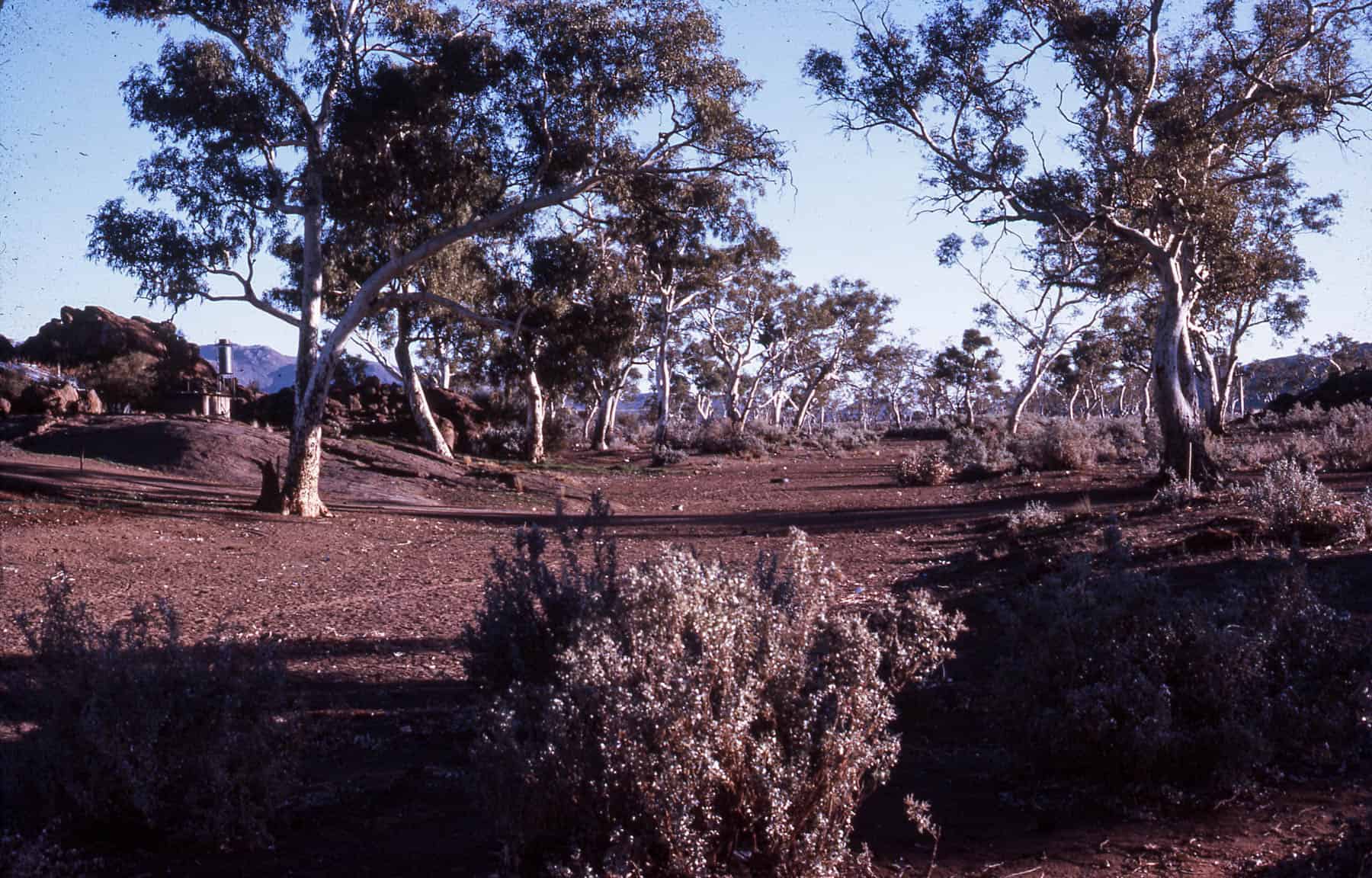 Australian bush. Photo: Alistair Knox
Australian bush. Photo: Alistair Knox
Each building or group of buildings should be placed and interrelated so that the re-ordered environment achieves a new sense of order and oneness such as it enjoyed in its original state. When developed in or around Australian cities, it means that the environment should be developed, or re-developed, until it becomes the strongest force in the area concerned. This would produce what I term the anti-city or the environmental city. It is anti-city because it permits man the thesis that permits men to congregate in small areas at the expense of nature. To do so creates a sense of life that was perhaps valid until recently, Today it is not. It lingers because we linger. We move from day to day hanging onto the old because we fear to change. Yet no matter where one goes, the cult of privacy goes hand in hand with affluence. Social intercourse is always most active among the poorer communities. The theory of superficial, undisturbed living in a complex society is, with few exceptions, a misconception. Nor is living in an environmental city as difficult and complex as it is argued. True, it is made difficult because no one has ever given way to it in the way we do to the great built-up cities. The longer we live within connected environment, the more we respond to it and it to us.
No one objects with sufficient emphasis to prevent precincts and special areas that develop in spite of everything in big cities to prevent them going. In the larger cities, the empirical rule is to get people into or near them so that capital expenditure may continue to appreciate. The short-sighted planning may be kept up. It is adding failure to failure. Everyone is prepared for the next generation to start world-wide planning, yet no decision can be made in the future: decisions are made in the present. In Sydney, the stores are now virtually finished. Shopping is done in areas. The same applies to Melbourne. I now consider that the suburbs of Melbourne hold more traffic than the city square between 9 a.m. and l2 p.m. most weekdays, and on Sunday.
It has already been stated that the whole of Melbourne is the biggest suburb in the world. Sydney itself is not far behind. There are several actual central areas in Sydney. In Melbourne, we can count Carlton, South Yarra, and little else. The potential of South Melbourne, Albert, and Middle Park have not so far registered. It doesn't matter much in the present bewildered sea of humanity where the centre lies. In Melbourne there is from year to year, depending on pressures of daily living, a changing flow of demand. Areas that have been depressed or are passé regain a new life because of demographic and ecological changes. The recent plan of the Melbourne and Metropolitan Board of Works for the development of corridors running out from Melbourne is the first glimmer of an environmental plan for the city. It allows for extension of size without strangulation. If the city radiates like the spokes of a wheel, leaving relatively undisturbed countryside in between, it should also be practicable to draw strands through the built-up areas. The notion that all cultural activities must spring from a single centre will quickly pass. Whether we like it or not, affluence looks for separation wherever it is possible. Melbourne appears to be fragmenting permanently. Perhaps the greatest deceitfulness of riches lies in this lack of love for our fellow men. If we can re-integrate society in terms of environment, we may produce a quality that all preceding centuries have had over the shrivelling world of this century. There will be many areas where this will not be so. But it does give an opportunity to develop them with a plan and a purpose. City cores could well be in the vicinity of 100,000 people each. It does not seem to matter whether a fair area of land is swallowed up to achieve this condition. In fact, if we do not liberate the city and its tangle, the present pattern must cause the city to stifle itself at an early date. With a car to every three persons, the more roads we have, the less the congestion. The theory of tiered living must be dismissed from the thinking mind. Its only justification would be protection from atomic explosion. The problem of services has already been referred to.
Environmental planning would catch water in smaller areas and dispose of sewerage in like manner. The cry concerning industry and services it the cry of fuzzy thinking. The transport system, which has changed the whole way of life in the twentieth century, needs twentieth-century understanding of a city. Many factories prefer to be built in open country. With the development of Westernport into what may possibly be Victoria's chief port, the way lies open for industry to be spread much further than it is at present, in the best economic interests. European cities have grown by slow processes of fluctuations of history. Australia is a phenomenon. It is a land untouched by white civilisation until less than two centuries ago. In addition, its only barrier to extension over its large land mass is water-hunger and the domination of sunlight. If we produce water which lies under the surface of the inland in the artesian basin, and harness the eastern rivers that flow into it, we can begin a process which will cause the domination of sunlight to recede to an extent that will not prohibit life, but instead will cause it to blossom gloriously.
The great development of the past centuries has concerned the exploitation of what is already there. This century is concerned with making the uninhabitable part habitable today.
In a sense, Australia stands on the razor's edge of the eastern highlands. Either she will slide to the east and into final declension and eventual extinction, or she will move out towards the centre and re-gather the vision of her forefathers.
Two new subjects should be available to all technical and high-school students: aviation - including becoming commercial pilots and navigators - or human communication over immense distances; secondly, a course in earth-moving and the use of and handling of machinery for the large-scale reforming of earth. Conservation requires that the present decimation of our topsoil be stopped immediately, lest it pass the point of no return. Water conservation and a true cultivation concept alone can do this. At present, our survival lies in the hands of fewer and fewer men. These are the men with the leathery faces and the far-away eyes.
The beautification of existing cities is important, but only to the degree that national conservation permits their continuance.
Town planners meditate a great deal these days about the myth of increasing leisure. In the fragile automation of the moment, this may be a factor. To make it a major plank in planning denies, at a blow, all true concern for a needy world - a world that is hungry, diseased, and unwanted.
Only the conservation of our natural growth and land masses stands between us and total destruction. The futility of the wealth of effort spent on reaching the moon in a world that cannot reach itself is pathetic and tragic. It is only a conflict of ego between conflicting ideologies. These have in common a lust for self-aggrandisement, the desire to control the many by the dominant few.
The world stands on the last frontiers of survival. Yet every rich country spends more on itself and self-indulgence to the exclusion of helping the underprivileged. Nor is it a matter of contributing a few dollars at Christmastime to a Christmas-bowl appeal. The smug attitude of many so-called Christian churches has betrayed much of their sacred trust of loving their neighbours as themselves. They piously read l Corinthians 13, Paul's chapter concerning love, on a Sunday; on Monday, they practice it by only loving those that love them. The word love has been made a mockery. Its main New Testament meaning is to be concerned for those we do not like.
Few can say that they prefer the teeming millions of Asia and India to the quiet of their own homes. But this is what love demands. And more than that, it demands the preservation and restoration of the capacity to survive. If one will drive the world, one must first be driven. It is no use reading with horror of violence that produced the pyramids. New York, London, Paris, San Francisco, Sydney, and Melbourne are just the same. They are built over dead-men's bones. Until we turn outward from ourselves, we are just as guilty.
 Alistair Knox (right) resting on the oars in New Guinea during the war. Martinadale in the background
Alistair Knox (right) resting on the oars in New Guinea during the war. Martinadale in the background
In 1963 I realised that, quite unknowingly, I had been hiding a sinful background to my life. I asked my Creator to show me what was wrong, and I really wanted to know. I asked and I received; I knocked and it was opened unto me; I sought and I found ... and, for once, I did what I was told. The first result was relief from the burdens of everyday life that seemed to leave no time for any worthwhile activity. The results were satisfactory to everyone but me up to that time. I was leaving a string of satisfied and enthusiastic clients and making those who copied part of our designs rich and prosperous. I was still experimenting and adding line to line. The environmental concept was growing visibly and could be seen whenever one drove around the great suburb of Melbourne, and also in Sydney, especially on the developing fringes.
Jesus said that He came in order that we might have life and have it more abundantly. I did not have the true fullness of this life. Only when was I forced to let go all of the old life did I receive the vision and excitement of a day-to-day experience that life can be eternally a growing forever. For the Christian, the best is always yet to be. No matter what joy we have today, it will be fuller in the future.
This joy is not a drag. It is not involved in a series of ideally arranged circumstances. It is an experience which is the product of a day-to-day faith. It is frequently involved with difficulties. Circumstances are mostly contrary, but the power to live and transcend them is always available. God is the giver of faith, and he gives it to anyone who will step out for Him and with Him.
The burdens of a complex experience I had had to struggle with were shared with others. As this happened, my financial resources increased. Planning fees have always been lucrative. But in the past, they had been paid into that bottomless pit: a building company. It was bottomless not because of day-to-day inefficiency, but because of faulty bookkeeping which threw up a picture of false security.
Each payment that came through planning could be used for our new building and its land. As I was determined to remain debt-free, there were times when I had to face the fact that if I were to be meticulously honest, I should stop building until money came in. As I meditated on one such occasion, I looked over planning schemes in hand. I chose the one that was nearest to completion to arrange an interview that night. It was not an interview I relished. The client was a nice young man of means, but one with whom I had found it hard to communicate. I thought that he would prove difficult from a financial point of view. We settled the final details of the plan, and I undertook to have it completed within a few days. He took out his cheque book and said, 'I want to pay you now for the plans'. I remonstrated, pointing out that the plans were not yet complete; but nothing would dissuade him. At length, I accepted the cheque gratefully. It permitted me to proceed with the building.
In all the changing conditions of this building, it was the same. Nearly everything came at about half-price. Nearly everything came - like Eric - at the precise moment at which I could no longer do without it. I was discovering that victory of life that Jesus meant and which He called the abundant life. It was just that: the adventure of overcoming the insurmountable. True victory lies not in our actions, but in actions motivated by faith in God.
Plans for environmental areas started to flow in as people saw and heard what could be done. Among the most interesting clients was Don Richardson, a man who was a modern pioneer. He was just over forty. His background had been similar to my own. We went to the same school and he, too, had been a leading seaman in the Royal Australian Navy at the time of war. In the navy, he had studied agriculture in his spare time.
After the war was over, he had taken up a farm in the Western District of Victoria. This area is generally a place of well-established properties where wealth and self-satisfaction are a generalisation. A few years later, he bought what is - in freehold and leasehold combined - the largest station in this state. Compared with South Australia, West Australia, and the Northern Territory it is, of course, pocket handkerchief. But it is tremendous in its power and its history ... and its challenges. It has a sense of one man against the whole of Australia. It is called Cobungra. The homestead is situated on the great plain, approximately 130 miles from Omeo on the Hotham Highway. This plain measures about three miles by three miles in the midst of the mountains. The old homestead was burned down late in 1966. The fire was first noticed from the air by men spreading super-phosphate on the paddocks nearby. The men landed their plane and rushed in in time to grab the records and books of the estate. The building was burned to the ground.
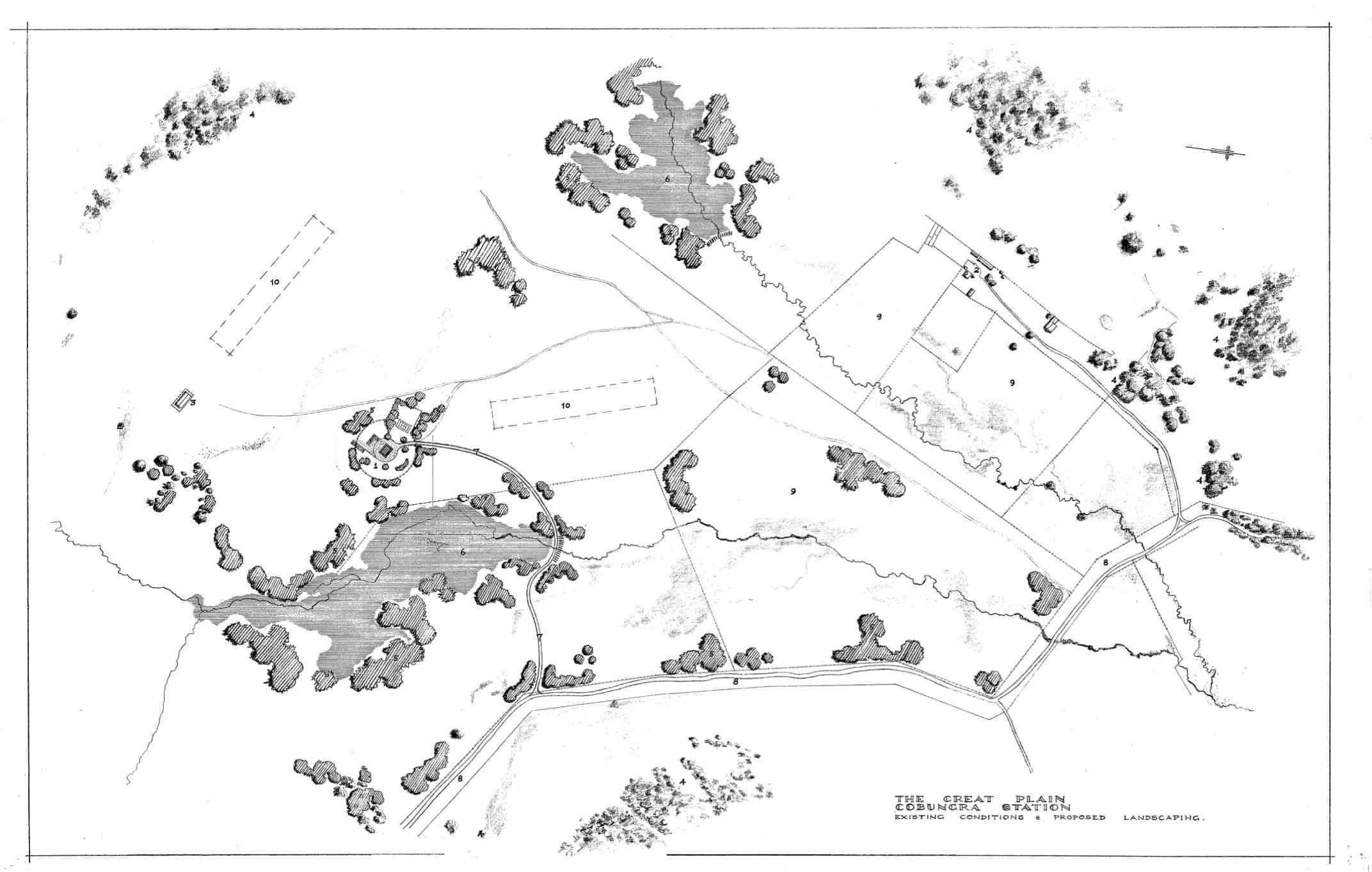 Cobungra Station: the great plain existing conditions & proposed landscaping
Cobungra Station: the great plain existing conditions & proposed landscaping
When Don Richardson first phoned me, I thought he might be one of those do-it-yourself hopefuls. He said he was in Melbourne. We arranged to meet. I was in for a surprise. I found he was a most capable and informed person on the subject. It was typical that he seemed effortlessly to find his way to me, who was probably the only person who could have rebuilt his house for him. It was the sort of work I revel in.
The next day we drove to the property, a distance of nearly 300 miles. To get there we had to traverse the land that McMillan, the first explorer of that part of Victoria, traversed 130 years ago. In most areas, the fairyland mysteries of the Gippsland bush had given way to dairy farms. Omeo itself is a small centre in the midst of the isolated centre in the midst of the big mountains of Victoria. It is full of pioneering history; of mountain hardships and struggles; of odd people; of gold-mining and cattle; of insular story.
Names rise out of the district that are nostalgic to all second-generation Victorians: Dargo High Plains, Hotham, Feather top Bogong, Buffalo, Harrietville, Bairnsdale, and Buchan. The cattle-men have names like the Faithfulls and the Treasures. Holdings of land are referred to by the surnames of the owners or the lease-holders, such as McNamara's, which might be an area in the mountains that only the cattle-men know. As we wound along the road that led to Cobungra, Don pointed out a mountain on the far horizon.
'That's one of the boundaries.' Between it and us lay fold upon fold of impenetrable - or apparently impenetrable - mountains and high plains. The scope was enormous. The station contains in freehold and leasehold 13,000 acres of great mountains and valleys, and part of the fabulous Bogong High Plains.
We arrived on the first day that cattle were being driven up into the highlands for the summer. We watched about 400 heifers tripping up a narrow gravel road. They stay there unfenced and unattended for several months, and Don indeed could have been a young version of the Man from Snowy River.
As the road wings up from Omeo to Mount Hotham, there are a number of names marked at high points and at corners. These tinge the imagination with melancholy. Names like Jack and Jim's, Mountain Maid, Flour-Bag, Mother Johnson's, Misty Flat ... evidence of a life that once was and now no longer exists.
As we returned to Cobungra at one of the busiest seasons of the year, Don had to make and re-make a series of decisions, according to the changes of the weather, every three or four hours. Gradually the pattern - as far as the eye could see in every direction, including the most distant mountains and the intervening ridges - became vast chessboard.
The cattle were the pieces, and the weather and the elements the opponents. Move and counter-move took place each morning and lunch-time. The moves were big, involving hundreds and thousands of cattle and sheep. Scientific systems were used where practicable, but the scale was so large that these had to become secondary. The main factors were men, horses, dogs.
Don explained that he could not bear the safety and security of his well-stocked and fenced property in the Western District. It had assured turns and seasonal rhythms. At Cobungra, the drama was ever-changing.
< Previous Book
< Previous Chapter
:
Next Chapter >
Next Book >
